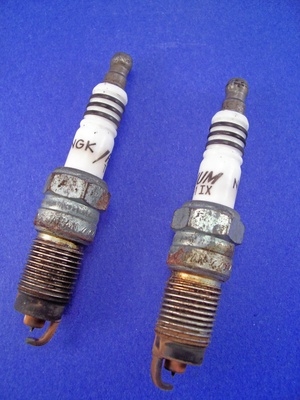
When troubleshooting a no-start condition on a 1994 Ford Taurus, the first challenge is to isolate the reason for a no-start to a specific area or system. To run, the Taurus needs to have a good battery and starter to turn the engine over. If the engine turns over, the engine needs fuel, ignition with the proper timing and sufficient compression. Eliminate any one of these and a no-start condition exists.
Attempt to start the car. The instrument lights should light up. If the engine fails to turn when the starter is engaged, something is wrong with the starter circuit. Lift the hood and hook the voltmeter to the battery by connecting the red lead to the positive terminal and the black lead to the negative. The reading should indicate 12.5 volts or better. If not, charge the battery and check the voltage again. If the voltage remains low, the battery needs to be replaced. If the voltage came up to 12.5 or better and the car starts, look at the display on the voltmeter with the engine running. The voltage should show a minimum of 13.8 volts to 14.5 volts if the alternator is functioning properly. If not, replace the alternator.
Check the starter for problems. If the battery tests good and the car will not start, check the terminals on the battery for corrosion and looseness. Look at the main positive wire from the positive terminal to the starter and see if there is any obvious corrosion or breaks--replace as necessary. Connect the black lead on the voltmeter to the negative terminal on the battery. Use the red lead to probe the red positive wire connection at the starter solenoid. The wire is good if the voltmeter reads 12 volts. If the voltmeter does not read 12 volts, replace the wire.
Disconnect the small wire on the solenoid located on the S terminal. Probe the small wire end with the red lead on the voltmeter while an assistant holds the key in the start position. There should be 12 volts as long as the key is in the start position. If there is voltage when the key is in the start position, the starter is bad. If there is no power (voltage), check the starter fuse in the fuse block under the hood. If the fuse is good, check the starter relay by pulling it out of its socket. Use the red lead from the voltmeter to probe the vacant relay terminals. Voltage should be present at one terminal with the key off; another one should show power when the key is in the start position only. If both show power at the appropriate time, the relay is bad. If there is no momentary power with the key in the start position, replace the ignition switch.
Look for engine management problems. Determine if the check engine light is on. Connect a code scanner to the OBD port located on the left lower side of the steering column under the dash. Turn the scanner on and press the key marked "Read." Reference the code displayed on the scanner to the sheet supplied with it. The problem will be indicated there.
Check to see if the fuel pump is operating by having a helper turn the key on and off for three seconds, then back on while you listen to the fuel pump. The fuel pump on a Taurus only operates for two seconds at a time when the key is turned on, unless the computer senses the engine is trying to start or has started. An audible "errrr" should be heard. If no sound is heard, the pump is not operating, hence the problem. To confirm the diagnosis, walk around to the engine and locate the Schrader valve on the fuel rail. Remove the cap from the valve. Using the small pocket screwdriver, push the Schrader valve in and hold it. Have your assistant turn the key to start. Get ready to release the Schrader valve because turning the key on will pressurize the fuel line; and if the pump is working, fuel will spray out of the valve. If there is no spray, the pump is not working. Check the fuel pump fuse in the fuse block under the hood. If it is good, replace the fuel pump. If there is fuel, the next check is for ignition.
Pull one of the spark plug wires off the plug and insert a spare spark plug into the end of the wire. Lay the spark plug against a good ground, such as the exhaust manifold, intake manifold bolts or accessories. Have your helper turn the engine over, with the key in the start position and watch for a good spark at the spark plug gap. If there is no spark, the ignition system is at fault and must be inspected. If there is a spark, the timing or compression must be the problem. To reiterate, if you have fuel, spark and air, you will have bang--a mechanic's term for ignition. In order for this ignition to effectively produce power, compression must be present. Several factors can cause lack of compression; and if this is the case, the factors need to be isolated independently.
Remove the spark plugs with the spark plug socket. Install the compression tester in each cylinder in succession, crank the engine for five revolutions then check the reading. Each cylinder must have 85 pounds per square inch plus; and when comparing all cylinders, they must be within 10 percent of one another, or the engine will run rough. If the compression is less than 85 pounds, an internal engine problem exists and needs to be addressed.